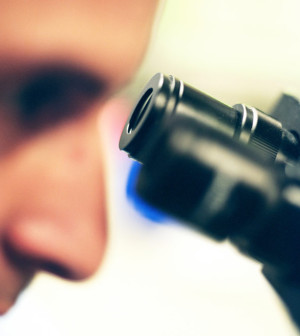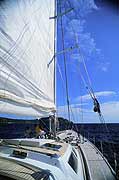- Skip Storing This Everyday Product in the Fridge Door
- Green Tea + B3 Pairing May Boost Brain Health
- Navigating Your Midlife Crisis: Embracing New Possibilities
- City Raccoons Showing Signs of Domestication
- Mapping the Exposome: Science Broadens Focus to Environmental Disease Triggers
- One Week Less on Social Media Linked to Better Mental Health
- Your Brain Changes in Stages as You Age, Study Finds
- Some Suicide Victims Show No Typical Warning Signs, Study Finds
- ByHeart Formula Faces Lawsuits After Babies Sickened With Botulism
- Switch to Vegan Diet Could Cut Your Greenhouse Gas Emissions in Half
Zaps From Electric Device May Prevent Motion Sickness


Motion sickness is a miserable experience, with sufferers having nausea, dizziness and cold sweats from the rocking of a boat, the swaying of a car or the swooping of a roller coaster.
Now imagine a device that could prevent those symptoms and allow you to enjoy your sailing excursion or day at the amusement park.
British researchers say such a device may soon be at hand. They have shown that a mild electrical current applied to the scalp can fend off these symptoms, according to findings published online Sept. 4 in the journal Neurology.
The electrical current interrupts confusing signals from the inner ear that lead to motion sickness. And the researchers say tests involving a small group of people showed promise in preventing nausea.
Such a current could be supplied by a small device or even the headphone jack of a mobile phone, the researchers suggest. They predict this cure for motion sickness will be on the market within a decade.
“We are confident that within five to 10 years people will be able to walk into the [drug store] and buy an anti-seasickness device,” said lead author Qadeer Arshad, an honorary research associate studying motion and balance at Imperial College London.
Motion sickness is a common complaint that can affect anyone. But about three in 10 people experience significant symptoms on long bus trips, on ships or in small aircraft, according to background notes.
The cause of motion sickness remains a mystery, but researchers suspect it occurs when what we see with our eyes or feel in our bodies is unable to line up perfectly with the balance messages that our brains receive from our inner ears.
So researchers decided to see if they could prevent motion sickness by interrupting the conflicting signals sent from the inner ear.
“We thought that this may be highly effective, and it proved to be the case,” Arshad said.
In the study, 20 volunteers wore electrodes on their heads for about 10 minutes. They were then placed in a motorized chair that rotates and tilts, to simulate the motions that tend to make people sick on boats or roller coasters.
People who received electrical stimulation took about 207 seconds longer to develop moderate nausea, compared with when they received “sham” treatment, the researchers found. Further, these people appeared to recover faster from motion sickness.
“It looks from the data like the correct stimulation significantly reduced the severity, time of onset and duration of symptoms in those patients, and really shortened the time of recovery,” said Dr. Sujana Chandrasekhar, director of the Comprehensive Balance Center of the New York Head & Neck Institute of Northshore-LIJ Health System.
However, Chandrasekhar questioned whether the amount of time by which motion sickness was delayed — about three-and-a-half minutes — would produce a “meaningful benefit” for most people.
“People take the Staten Island Ferry to work. That’s a 10-minute ride. If you can delay the onset by three or four minutes, then you’re nearly done with your commute,” she said. “But for people facing longer exposure, this may not be helpful.”
It would be nice if people could zap themselves repeatedly as they begin to feel symptoms of motion sickness, Chandrasekhar said, but “we don’t know if that’s safe or feasible.”
Arshad responded that the effect noted in this study “is equivalent to the current gold standard drug (Scopolamine) developed by the U.S. Army” for motion sickness, but does not cause the drowsiness associated with most seasickness drugs.
Dr. Bernard Cohen, a professor of neurology with the Icahn School of Medicine at Mount Sinai, had a different concern. He worries that the electrical stimulation might cause seizures or significant effects on mental function in some people.
“They’re trying to change your perception of what these symptoms are, with the brief electrical stimulation of the cortex,” Cohen said. “I have to tell you, I have some reservations about that.”
But Arshad said that the electrical current is not harmful, and that in other studies his team has shown that stimulating the brain in this way can enhance attention and concentration.
“The currents involved are very small and there is no reason to expect any adverse effects from short-term use,” he said.
More information
For more on motion sickness, visit the U.S. Centers for Disease Control and Prevention.
Source: HealthDay
Copyright © 2025 HealthDay. All rights reserved.










